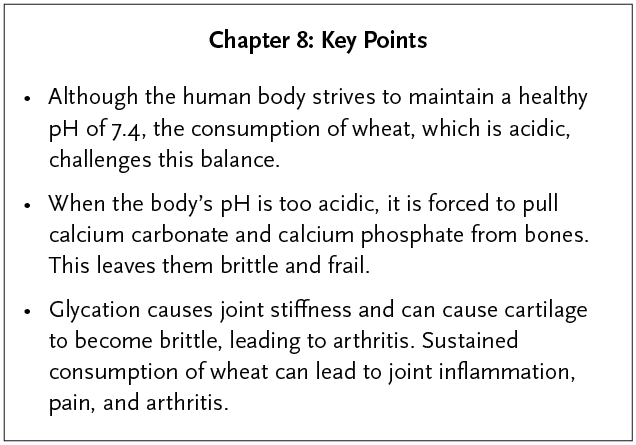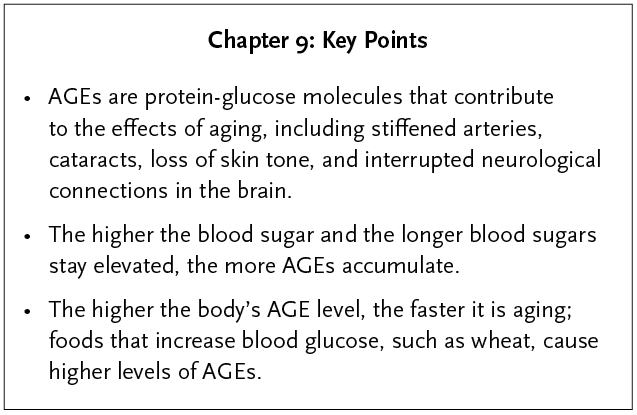Summary: Wheat Belly ...in 30 Minutes (5 page)
Read Summary: Wheat Belly ...in 30 Minutes Online
Authors: 30 Minute Health Summaries

DROPPING ACID: WHEAT AS THE GREAT PH DISRUPTER
Overview
According to Davis, altering the body's healthy pH level of 7.4 by just 0.5 in either the acidic or alkaline direction is dangerous. Wheat products, which release high levels of sulfuric acid, effectively tip the balance to the acidic side. When the body senses an overabundance of acid, it draws calcium (an alkali) from the bones, which can leave them dangerously depleted. Wheat can also cause the cartilage that cushions the joints to become stiff and brittle. Davis suggests that removing wheat from the diet can alleviate these conditions.

“[W]heat exerts direct and indirect bone- and joint-destructive effects in any wheat-consuming human.”
â Dr. William Davis,
Wheat Belly

Chapter Summary
For the body to function properly, it needs to maintain a pH of 7.4. Foods that come from animal sources, such as meats and cheeses, are acidic â although animal proteins also exert a bone-strengthening effect by triggering the production of a hormone called IGF-
1
, which spurs bone growth and mineralization. Eating vegetables and fruits, which are alkaline, can also counterbalance the acidic effects of meats. Grains are the only plant products that generate acids. Wheat is particularly acidic, yielding more sulfuric acid per gram than any meat. A typical Western diet, dominated by meat and wheat products, tips the body's pH toward the acidic.
An acidic pH triggers the body to draw calcium (an alkali) from the bones and stimulates cells within the bones to dissolve bone tissue in an effort to release their calcium more quickly. Davis suggests that both of these processes deplete the bones of calcium, causing them to become brittle and frail.
Davis says wheat also plays a role in arthritis. Arthritis, long thought to be a complication of the wear and tear of excess weight on the joints, is an inflammation process, and Davis reminds us that excess visceral fat causes inflammation. Studies show that losing visceral fat improves arthritis more than can be expected from weight loss alone.
Glycation is another process that can complicate arthritis. Glycation is a reaction that takes place when simple sugar molecules become attached to proteins or fats. This results in the formation of rogue molecules known as advanced glycation end products (AGEs), which cause protein fibers to become stiff and malformed. Cartilage, which cushions the joints, is especially susceptible to glycation because cartilage cells do not reproduce; once they are damaged, they remain damaged. Consuming wheat increases blood glucose levels and causes glycation. Since damage due to glycation is cumulative, the more wheat ingested, the more harmful the effects.

“Modern eating patterns therefore create a chronic acidosis that in turn leads us to osteoporosis, bone fragility, and fractures.”
â Dr. William Davis,
Wheat Belly



CATARACTS, WRINKLES, AND DOWAGER'S HUMPS: WHEAT AND THE AGING PROCESS
Overview
AGEs are molecules that form when glucose binds to protein. These molecules accumulate in the body's organs, where they interfere with normal functioning, triggering the effects of aging. Davis suggests that consuming large quantities of wheat accelerates this process by supplying the blood with high levels of sustained glucose that can be converted to AGEs. He hypothesizes that a diet low in wheat should have the opposite effect, slowing the parts of the aging process affected by AGEs.

“Wheat, because of its unique blood glucose-increasing effect, makes you age faster. Via its blood sugar/AGE-increasing effects, wheat accelerates the rate at which you develop signs of skin aging, kidney dysfunction, dementia, atherosclerosis, and arthritis.”
â Dr. William Davis,
Wheat Belly

Chapter Summary
Advanced glycation end products, or AGEs (introduced in the previous chapter), are essentially useless debris that accumulates in the organs and results in tissue decay. They can cause stiffened arteries, cataracts, dementia, loss of skin tone, and other deteriorations that signal the aging process. The stiffening caused by AGEs is irreversible, and the older people get, the more AGEs can be found in all their organs.
AGEs are found in some foods, but are also a byproduct of high blood sugar. In people with extremely high blood sugar levels, such as diabetics, AGEs can accelerate the aging process. The higher the blood sugar and the longer blood sugars stay elevated, the more AGEs accumulate, creating a faster buildup and a more noticeable impact. Many diabetics in their twenties and thirties suffer from atherosclerosis, kidney disease, and neuropathy â diseases most commonly found in people ages sixty and over. AGEs are also responsible for most of the complications of diabetes.
AGEs also form when blood sugar is normal â although at a much lower rate. But consuming large quantities of wheat products, because of their effects on blood sugar, can cause AGEs to form and accelerate the changes associated with aging.
HbA
1
c is a blood test that gauges the rate of AGE formation by measuring the average plasma glucose concentration over prolonged periods of time; the higher the average blood glucose levels, the higher the HbA
1
c. According to Davis, the higher a body's HbA
1
c level, the faster it is aging, as well. When foods that increase blood glucose levels, such as wheat, are ingested regularly, they tend to increase HbA
1
c levels. Davis proposes that a diet low in wheat should, therefore, slow the aging process, although this has not yet been studied.

“[F]oods that increase blood glucose levels the most and are consumed more frequently are reflected by higher levels of HbA1c that in turn reflect a faster rate of organ damage and aging.”
â Dr. William Davis,
Wheat Belly

